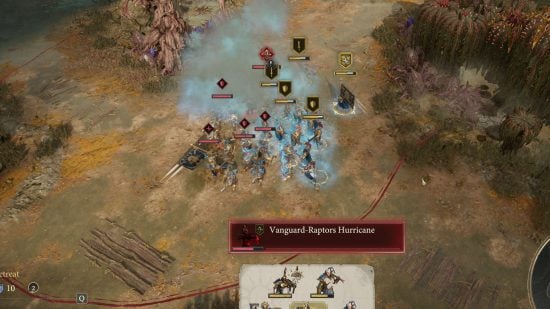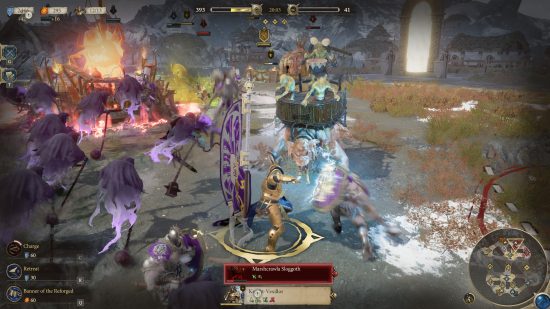Recent RTS Warhammer Age of Sigmar: Realms of Ruin has sold badly. Like, really badly. SteamSpy estimates somewhere from 20,000-50,000 owners on the platform, while SteamCharts estimates its peak concurrent player count to have been 1,556. The disastrous launch caused publisher Frontier’s share price to tank by almost 20% in a day. Which is a damn, damn shame, because Realms of Ruin is really good.
As I said in my Realms of Ruin review, it’s a fantastic and modern strategy game – for the right player. Frontier is in real trouble if there simply aren’t many of that kind of player out there. I think they do exist, but preconceptions about the RTS genre are preventing them from seeing Realms of Ruin’s quality.

Realms of Ruin is not a traditional RTS game, so traditional RTS fans are understandably disappointed by it – and I can’t really blame them for not digging deeper. Meanwhile, gamers who don’t see themselves as RTS enjoyers will find mostly negative reactions from genre aficionados. They won’t realise how well Realms of Ruin pares back the peripheral trappings of the genre to expose its true, beating heart.
The classic design elements we associate with the RTS genre – base building, base-destruction as a win condition, using buildings to produce units and research tech, resource harvesting, turtling, tank rushes – are a legacy from Dune II, the first true RTS game, which were codified and popularized by the original Command and Conquer. But you don’t need any of them to make an RTS.
Winning an RTS – winning any real time game – is about making better use of two irreplaceable assets, time and attention, than your opponent. Every second that passes in the game, players try to gain resources or destroy their opponents’ resources, fulfil victory conditions or deny their opponents’ victory conditions, while dividing their attention across multiple priorities.
Your armies, upgrades, and structures, crystalise your irreplaceable time and attention into useful but fragile tools. Your tactics are the choices you make to respond to the current state of the game. Your strategy manifests through choices that shape the future state of the game. You’ll trade off tactical setbacks in exchange for strategic gains, or postpone strategic goals to preserve tactical assets. The player who makes more good choices for longer wins.
That’s it. That’s the genre.
Base-building offers unique strategies and tactics, as well as a certain gameplay feel – building, protecting, and destroying infrastructure is cool! But you don’t need those systems for a game to have strategic depth. You hardly need any. Go consists of a single system, placing pieces on a board, but its strategic depths are still being explored after 4,000 years.
If you adore base building, more power to you. I fully understand why you’re turning your nose up at Realms of Ruin – it’s not serving what you want. But that doesn’t disqualify it from being a great RTS.

The single-player campaign is also a long tutorial for multiplayer: common enough among RTS games that don’t also have an overworld campaign (as in Total War Warhammer 3, or the classic Warhammer 40k game Dawn of War Soulstorm), but a disappointment for single-player only gamers – though there is the procedural Conquest mode for them.
But there are plenty of strategy gamers out there who don’t feel that building a small town is a prerequisite to a decent battle, and often enjoy battles bereft of an authored narrative; miniature wargamers and turn-based strategy game fans particularly.
For players used to turn-based tactics games like XCOM, Realms of Ruin makes the “real time” part of real time strategy far less painful. Particularly, it clarifies the options that are actually available to the player, and the stakes attached to their decisions, so that they can engage with the real challenge – outthinking their opponent.
Take “combat engagement”. When two units make contact, they’re stuck fighting one another until one dies. Special activated abilities might offer a way to escape, and every unit can retreat, running back to homebase to heal. This is a simplification compared to other RTS games, in which units remain free to move – in theory, at least. In practise, a faster unit can keep a slower unit engaged, provided its controller keeps directing it to attack.
Realms of Ruin’s engagement system puts a cap on the amount of micro-management and mental bandwidth the player has to commit to the minutiae of combat. And since the outcome of a combat is always death, victory, or retreat to home base, the stakes of combat are very easy to understand.
The options for the player, and the risks associated with them, are more obvious. But just because the choice facing the player is clearly defined, doesn’t mean that the correct answer is easy to determine.
Unit upgrades are similar. There are (usually) two upgrades for each unit, and they’re mutually exclusive. Which is the right one? Depends what your opponent is doing now, and what you think they’re going to be doing in 10 minutes time. Or maybe you need that Realmstone to upgrade your base by a tier instead. Or for a powerful ability to turn an important combat in your favor…?
In a trad RTS, before you could even make a decision about unit upgrades, you’d first need to construct multiple buildings. There are definitely interesting strategic decisions that arise from tying your upgrades and unit construction capabilities to vulnerable physical infrastructure; but that also puts the interesting strategic decisions about which upgrades to choose a whole system further away from the player.
I called Realms of Ruin a ‘clean’ design in my review, and perhaps I can expand on that. The RTS genre often puts multiple layers of interface and memorisation between the player and the actual strategic picture of the battlefield, and the freedom it offers all too often gives victory to the person who can click the fastest. Where Realms of Ruin has streamlined the genre, it has done so to bring the interesting part of the game – a duel of wits and decisions with your opponent – closer to the surface.
If you’re a strategy gamer who doesn’t think they like RTS games, Realms of Ruin could be your entry point to the genre. If you’re a trad RTS gamer who’s pissed that they bought the game and played too much of it to get a Steam refund, give it another go, judging it for what it is, not what it isn’t.
Still not convinced? For something from a similar design tree but closer to the RTS root, check out our Company of Heroes 3 review. Similarly a little maligned on launch, but – we suspect – mostly because it’s very similar to Company of Heroes 2, which is supported with years and years of DLC.
If you’re still on the fence about Games Workshop’s modern fantasy setting, let our guide to the Age of Sigmar armies change your mind – or if you’re dead set against, there’s always the incoming Warhammer The Old World release date to look forward to.




